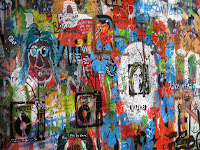 Wednesday, April 7, 2010 (Part 4):
Wednesday, April 7, 2010 (Part 4):Like many large cities in eastern Europe, Prague has a long history of being home to a large Jewish population. And like other such cities, the Jews of Prague were targeted for extermination as part of Hitler's campaign to destroy this race of people. We had tried to tour the Jewish Quarter of Prague on our first day here, but had to wait two days until the synagogues re-opened to the public following a period of Jewish holidays.
The Jewish Quarter has a very organized tour route and audio guide, and we followed it completely. We had to wait in a long line to purchase our tickets, but once we got started we found it all fascinating. We visited a total of five synagogues, a Jewish cemetery and a ceremonial hall. It took us four hours!
The tour began at the Pinkas Synagogue. This is a very old synagogue -- many of hundreds of years old. It is now a permanent memorial to the Prague Jews who were exterminated at the death camps during World War II. On the interior walls of this synagogue are hand-inscribed the names of the more than 77,000 Jews from Prague who were killed during the war. This is a very moving monument. Conceptually, it reminded me of the Vietnam War Memorial on the Mall in Washington, D.C. The names are arranged alphabetically. The family name is in red block type, followed by each family member's first name, date of birth and date sent to the death camps. Stars also denote the beginning and ending of a family grouping.

Also of note, these names were first inscribed in the early 1950s. When the city came under communist influence and was occupied by the Russians in the late 1950s, 1960s and 1970s, the names were obliterated. When the city emerged from communist rule in the 1970s, the names were inscribed all over again!
Pictures were prohibited inside any of the synagogues, so I have selected here (i) a picture of an interesting building on one of the central street corners in the Jewish Quarter that featured a nice statue on the exterior corner of the fourth floor, and (ii) a picture of the clock tower on top of the Jewish Town Hall within the Jewish Quarter.




 010 (Part 9):
010 (Part 9): Yum! (So much for my diet.)
Yum! (So much for my diet.)






 sections, an upper and a lower section. Because we were arriving before the lunch hour, we had a wonderful selection of seating options. We chose a table directly on the water. It was great! We enjoyed a very nice lunch of salads and we took advantage of our relaxing break to write a few postcards.
sections, an upper and a lower section. Because we were arriving before the lunch hour, we had a wonderful selection of seating options. We chose a table directly on the water. It was great! We enjoyed a very nice lunch of salads and we took advantage of our relaxing break to write a few postcards.























 4, 2010 (Part 1):
4, 2010 (Part 1):








